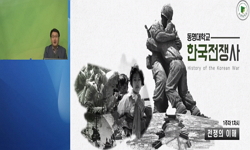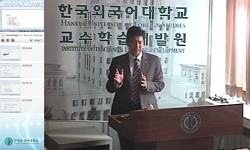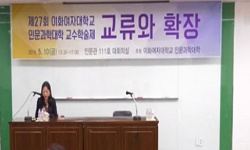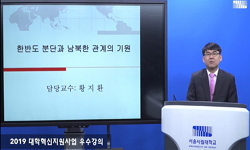The purpose of this article is to study the charater and traasition aspects in those days through “InsengyoukMacha” published in book form, while noting unprecedented popular success of “InsengyoukMacha” in 1950s. This study takes the first ed...
http://chineseinput.net/에서 pinyin(병음)방식으로 중국어를 변환할 수 있습니다.
변환된 중국어를 복사하여 사용하시면 됩니다.
- 中文 을 입력하시려면 zhongwen을 입력하시고 space를누르시면됩니다.
- 北京 을 입력하시려면 beijing을 입력하시고 space를 누르시면 됩니다.

1950년대 라디오 프로그램 ≪인생역마차≫의 성격과 매체 전이 양상 = The Character and Media Transition Aspects of a Radio Programs “InsengyoukMacha” in 1950s
한글로보기https://www.riss.kr/link?id=A104041782
-
저자
최미진 (부산대학교)
- 발행기관
- 학술지명
- 권호사항
-
발행연도
2008
-
작성언어
Korean
-
주제어
“InsengyoukMacha” ; solution programs ; radio narratives ; real-story play ; temporal reversal technique ; dramatic structure ; characteristic narrater ; a solid reading aloud ; The Korean War ; patriarchal ideology ; transition aspects ; 인생역마차 ; 솔루션 프로그램 ; 라디오서사 ; 실화극 ; 시간의 역전기법 ; 극적 구성 ; 성격있는 나레이터 ; 입체낭독 ; 한국전쟁 ; 가부장제 이데올로기 ; 전이양상 ; “InsengyoukMacha” ; solution programs ; radio narratives ; real-story play ; temporal reversal technique ; dramatic structure ; characteristic narrater ; a solid reading aloud ; The Korean War ; patriarchal ideology ; transition aspects
-
등재정보
KCI등재
-
자료형태
학술저널
- 발행기관 URL
-
수록면
363-388(26쪽)
-
KCI 피인용횟수
11
- 제공처
-
0
상세조회 -
0
다운로드
부가정보
다국어 초록 (Multilingual Abstract)
“InsengyoukMacha” is radio narrative which falls under the story part of the solution program of “InsengyoukMacha”. The contents feature was that first, it was mainly composed of tragic characteristics and the Korean War was taken as a starting point. It seemed to draw a wide appeal to the listeners in a point of visualizing a tragic situation caused by the Korean War based on the real story. Second, it dealt with various aspects of people's lives, and especially placed a great deal of weight on family matters. By taking social matters like reunion of postwar-separated family and reorganization as a modern family system, it aroused people's sympathy. Third, the main characters of conflicts revealed various age and gender gap, especially the part of women was heavy. Women had an aspect of expressing their moral distresses surrounded by a patriarchy ideology rather than that of positive and active personality. Fourth, a social common notion which dominated the postwar Korean society and reinforcement of a patriarchy ideology were concentrated. While these contents and features of “InsengyoukMacha” vividly presenting the social reality faced with those days' radio broadcasting, implied the possibility of the function as ideological mechanism.
As we observed the publication of “InsengyoukMacha”, the effect caused by “InsengyoukMacha” was enormous. In watching the internal transition aspect of radio media, “InsengyoukMacha” not only mass produced the programs which had similar formats or titles, but also lead the era of the full-scale real-story play. It is a particular fact that it provided various materials for the writers who would lead the golden age of radio drama in 1960s. Remarkable transition aspect of other media was found in the film production of “InsengyoukMacha” and its box-office success.
“InsengyoukMacha” was the first program that filled the gap between the mid 1950s radio as an advanced medium and the popularization of radio programs. “InsengyoukMacha” which showed the possibility of radio drama as an example of contents was quite meaningful as a starting point of opening fields of radio drama and radio documentaries.
The purpose of this article is to study the charater and traasition aspects in those days through “InsengyoukMacha” published in book form, while noting unprecedented popular success of “InsengyoukMacha” in 1950s. This study takes the first edition through the third edition of “InsengyoukMacha” as research objects, while digging and introducing the second and the third edition of the book “InsengyoukMacha”.
“InsengyoukMacha” is radio narrative which falls under the story part of the solution program of “InsengyoukMacha”. The contents feature was that first, it was mainly composed of tragic characteristics and the Korean War was taken as a starting point. It seemed to draw a wide appeal to the listeners in a point of visualizing a tragic situation caused by the Korean War based on the real story. Second, it dealt with various aspects of people's lives, and especially placed a great deal of weight on family matters. By taking social matters like reunion of postwar-separated family and reorganization as a modern family system, it aroused people's sympathy. Third, the main characters of conflicts revealed various age and gender gap, especially the part of women was heavy. Women had an aspect of expressing their moral distresses surrounded by a patriarchy ideology rather than that of positive and active personality. Fourth, a social common notion which dominated the postwar Korean society and reinforcement of a patriarchy ideology were concentrated. While these contents and features of “InsengyoukMacha” vividly presenting the social reality faced with those days' radio broadcasting, implied the possibility of the function as ideological mechanism.
As we observed the publication of “InsengyoukMacha”, the effect caused by “InsengyoukMacha” was enormous. In watching the internal transition aspect of radio media, “InsengyoukMacha” not only mass produced the programs which had similar formats or titles, but also lead the era of the full-scale real-story play. It is a particular fact that it provided various materials for the writers who would lead the golden age of radio drama in 1960s. Remarkable transition aspect of other media was found in the film production of “InsengyoukMacha” and its box-office success.
“InsengyoukMacha” was the first program that filled the gap between the mid 1950s radio as an advanced medium and the popularization of radio programs. “InsengyoukMacha” which showed the possibility of radio drama as an example of contents was quite meaningful as a starting point of opening fields of radio drama and radio documentaries.
참고문헌 (Reference)
1 한국방송공사, "한국방송사" 한국방송공사 1977
2 한국방송인클럽, "한국방송보도70년사" 한국방송인클럽 1994
3 김성호, "한국방송관계문헌색인:1945~1982" 한국방송사업단 1984
4 정진석, "한국방송관계기사모음:1924-1955" 관훈클럽신영연구기금 1992
5 노정팔, "한국방송과 50년" 나남 1995
6 정진석, "한국방송 80년,그 역사적 조명" 나남 2008
7 조항제, "한국 방송의 역사와 전망" 한울 2003
8 최현철, "한국 라디오 프로그램에 대한 역사적 연구" 한울 2004
9 하유상, "창작법십오강" 성문각 1965
10 방송문화연구실, "제二차 여론조사 중간결과-선생님도 인생역마차를 좋아한다" 3 (3): 1958
1 한국방송공사, "한국방송사" 한국방송공사 1977
2 한국방송인클럽, "한국방송보도70년사" 한국방송인클럽 1994
3 김성호, "한국방송관계문헌색인:1945~1982" 한국방송사업단 1984
4 정진석, "한국방송관계기사모음:1924-1955" 관훈클럽신영연구기금 1992
5 노정팔, "한국방송과 50년" 나남 1995
6 정진석, "한국방송 80년,그 역사적 조명" 나남 2008
7 조항제, "한국 방송의 역사와 전망" 한울 2003
8 최현철, "한국 라디오 프로그램에 대한 역사적 연구" 한울 2004
9 하유상, "창작법십오강" 성문각 1965
10 방송문화연구실, "제二차 여론조사 중간결과-선생님도 인생역마차를 좋아한다" 3 (3): 1958
11 제이 데이비드 볼터, "재매개: 뉴미디어의 계보학" 커뮤니케이션북스 2006
12 "인생역마차, 「경향신문」 1956.3.23"
13 최창봉, "우리방송 100년" 현암사 2001
14 "영화-국성사ㆍ중앙-인생역마차(11일부터), 「동아일보」 1956.9.13"
15 문윤곤, "연속방송극 부움의 1년" 2 (2): 1957
16 "신세기영화작품 인생역마차, 「경향신문」 1956.1.4"
17 요시미 슌야, "소리의 자본주의" 이매진 2005
18 "설문 방송에 대한 견해" 1 (1): 1956
19 김 울, "비약의 1년" 3 (3): 1958
20 방송문화진흥회, "방송대사전" 나남 1990
21 최요안, "방송극연구" 인간사 1963
22 배옥천, "방송과 청취자" 2 (2): 1957
23 마샬 맥루한, "미디어의 이해" 커뮤니케이션북스 2005
24 "라디오 텔레비(13일), 「동아일보」 1959.9.13"
25 "기자생활모독-인생역마차 상영철회요구, 「조선일보」 1956.9.12"
26 "경이적인 기록 ‘푸른 대륙’ 현대극 ‘인생역마차’ ‘물레방아', 「여원」 1956년 11월호"
27 "人生驛馬車는 어떻게 放送되는가?" 1 (1): 1956
28 "人生驛馬車 제3집" 희망사 1957
29 "人生驛馬車 제2집" 희망사 1956
30 "人生驛馬車 제1집" 희망사 1956
31 Andrew Crisell, "Understanding Radio" London and New York: Routledge 1994
32 W. James Potter, "Theory of Media Literacy:A Cognitive Approach" London: Sage Publication 2004
33 J. Lull,, "Media, Communication, Culture" New York: Columbia University Press 1995
34 방송문화연구실, "KBS연감 1963" 한국방송문화협회 1962
35 Frank Lentricchia, "Critical Terms for Literary Study" Chicago & London: Chicago UP 1990
동일학술지(권/호) 다른 논문
-
- 한국문학이론과비평학회
- 정종진
- 2008
- KCI등재
-
차이들의 우주적 네트워크 ― 2000년대 한국소설의 패러다임
- 한국문학이론과비평학회
- 송지연
- 2008
- KCI등재
-
- 한국문학이론과비평학회
- 한승옥
- 2008
- KCI등재
-
<황석영 소설의 텍스트 확정을 위한 고찰> -초기 소설을 중심으로
- 한국문학이론과비평학회
- 임기현
- 2008
- KCI등재
분석정보
인용정보 인용지수 설명보기
학술지 이력
| 연월일 | 이력구분 | 이력상세 | 등재구분 |
|---|---|---|---|
| 2022 | 평가예정 | 재인증평가 신청대상 (재인증) | |
| 2019-01-01 | 평가 | 등재학술지 유지 (계속평가) |  |
| 2016-01-01 | 평가 | 등재학술지 선정 (계속평가) |  |
| 2015-12-01 | 평가 | 등재후보로 하락 (기타) |  |
| 2011-01-01 | 평가 | 등재학술지 유지 (등재유지) |  |
| 2009-01-01 | 평가 | 등재학술지 유지 (등재유지) |  |
| 2007-01-01 | 평가 | 등재학술지 유지 (등재유지) |  |
| 2004-01-01 | 평가 | 등재학술지 선정 (등재후보2차) |  |
| 2003-01-01 | 평가 | 등재후보 1차 PASS (등재후보1차) |  |
| 2001-07-01 | 평가 | 등재후보학술지 선정 (신규평가) |  |
학술지 인용정보
| 기준연도 | WOS-KCI 통합IF(2년) | KCIF(2년) | KCIF(3년) |
|---|---|---|---|
| 2016 | 0.68 | 0.68 | 0.69 |
| KCIF(4년) | KCIF(5년) | 중심성지수(3년) | 즉시성지수 |
| 0.69 | 0.68 | 1.285 | 0.21 |




 KCI
KCI KISS
KISS






